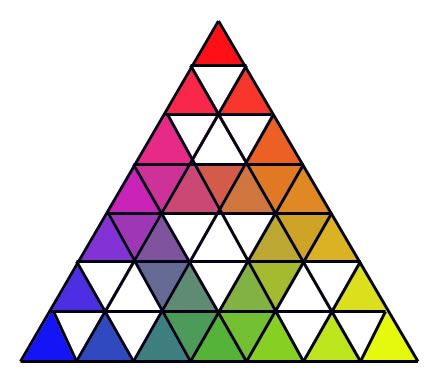Χρωματικό τρίγωνο – παρατηρήσεις (συμπλήρωμα) – Color triangle – remarks (supplement)
Παρατηρήσεις επί του Χρωματικού Τριγώνου (συμπλήρωμα)
Στο προηγούμενο post προσέχοντας στον τριγωνοποιημένο χρωματικό κύκλο πως κάθε πλευρά του ισόπλευρου αυτού τριγώνου απαρτίζεται από 7 μικρότερα ισόπλευρα τρίγωνα, σκέφτηκα να ομαδοποιήσω και χρωματίσω κάθε σειρά 7 μικρότερων τριγώνων που εμπεριέχεται μέσα στο αρχικό χρωματικό τρίγωνο.
Χρησιμοποιώντας λοιπόν τον σεπτό αριθμό «ἑπτά» και προσδίδοντας το χρώμα τους στα τριγωνάκια κάθε επτάδας, είδα το τρίγωνο να χωρίζεται σε δυο ομάδες:
Α) αυτή με τα 43 = 4 + 3 = 7 χρωματισμένα τρίγωνα
Β) αυτή με τα 6 εναπομείναντα άχρωμα (λευκά;) τρίγωνα.

Το αποτέλεσμα αυτό με επανέφερε στο επίμαχο ζήτημα της περίεργης σχέσης του 6 με το 7, όπως και στο πρόβλημα των χρωμάτων του ορατού φάσματος. Τελικά τα χρώματα είναι 6 ή 7;
(Δες posts: «Ο χρωματικός κύκλος», «Κίτρινο και μωβ, μια περίεργη σχέση»).
Προβλέποντας ότι η αριθμητική και η χρωματική παρατήρηση και μελέτη του χρωματικού τριγώνου θα μας οδηγήσει και σε άλλες «ανακαλύψεις» σας προέτρεψα να ασχοληθείτε με αυτό.
Επεξεργαζόμενοι σταδιακά το χρωματικό τρίγωνο, ώστε να καταλήξουμε στο τελικό σχήμα που σας παραθέσαμε στο post «Παρατηρήσεις επί του χρωματικού τριγώνου» προέκυψαν διάφορα ενδιάμεσα σχήματα – καταστάσεις, τα οποία θεωρώ ότι αξίζει να αναρτηθούν, ώστε να βοηθήσουν ή ερεθίσουν περισσότερο στην έρευνα και μελέτη των ενδιαφερομένων.
Τα ενδιάμεσα αυτά σχήματα προκύπτουν από τους συνδυασμούς:
α) τρίγωνα βάσεων + τρίγωνα καθέτων

β) τρίγωνα βάσεων + τρίγωνα μεσαίων σειρών

γ) τρίγωνα καθέτων + τρίγωνα μεσαίων σειρών

Νομίζω πως πρόκειται για μια ενδιαφέρουσα έρευνα που θα κεντρίσει αρκετούς από εσάς να ασχοληθείτε μαζί της.
Color triangle – remarks (supplement)
In a previous post, watching the chromatic circle being triangulated I noticed that each side of this equilateral triangle consists of 7 smaller equal triangles, I decided to group and color each row of 7 smaller triangles contained within the original triangle.
Using the ‘respectable’ number "seven" and assigning their color to the triangles of each group of seven, I noticed the triangle divided into two groups:
A) the group of 43 = 4 + 3 = 7 colored triangles
B) the group of the remaining 6 blanc (colorless? white?) triangles.
This result brought me back to the controversial issue of the strange relationship between 6 to 7, as well as to the problem of the colors of the visible spectrum. Finally are the colors 6 or 7?
(Watch posts: "The Color Circle," "Yellow and Purple, a Weird Relationship").
Foreseeing that the arithmetic and color observation and study of the color triangle will lead us to other "discoveries" I urged you to deal with it.
Processing gradually the color triangle in order to arrive at its final shape given to you in the post "Observations on the color triangle", a number of intermediate shapes – situations emerged, that I think are worth posting to help or stimulate more research and study of the interested parties.
These intermediate schemes result from combinations of:
A) triangles of bases + perpendicular triangles
B) base triangles + middle triangles
C) vertical triangles + middle triangles
I believe that this is an interesting survey that will spur many of you to deal with it.
admin is | Topic: Αριθμοί και χρώματα, Χρωματικός κύκλος | Tags: 6, 7, χρωματικό τρίγωνο

No Comments, Comment or Ping
Reply to “Χρωματικό τρίγωνο – παρατηρήσεις (συμπλήρωμα) – Color triangle – remarks (supplement)”